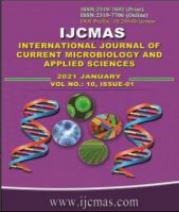


 National Academy of Agricultural Sciences (NAAS)
National Academy of Agricultural Sciences (NAAS)

|
PRINT ISSN : 2319-7692
Online ISSN : 2319-7706 Issues : 12 per year Publisher : Excellent Publishers Email : editorijcmas@gmail.com / submit@ijcmas.com Editor-in-chief: Dr.M.Prakash Index Copernicus ICV 2018: 95.39 NAAS RATING 2020: 5.38 |
Insect pests are the most destructive constraints to world agriculture. They damage millions of hectares of crops belonging to food grains, horticulture crops every year. The extent of damage is increasing year after year under the influence of changing climatic conditions. The developing economies suffer more due to outbreak of insect pests in fruits and vegetables which are the major source of international trade. India produces almost all the vegetables which are consumed inside and exported to other countries. But, insect pests create a major barrier to production and productivity as they are causing several outbreaks. Chemical pesticides are being used to manage these insect pests in order to achieve quick control. But, in many cases, misuse of pesticides led to environmental pollution along with population resurgence, pesticidal residue problem in soil and water, and pest resistance to these chemical pesticides. In such situation, biological control gives a promising hope towards sustainable pest management. Biological control is the, usage of living organisms and their products alternative to chemical pesticides or integrating as one of the component in integrated pest management program. Here, we can employ various biological control agents like natural enemies (predators and parasitoids), entomopathogenic fungi, bacteria, virus, nematodes, protozoa and actinomycetes or their products for effective pest management. They can be directly used or formulated into a commercial formulation suitable for various methods of application. Classical biological control is well-tried, cost effective approach to manage various pests in vegetable crops. Since we use native strains of biocontrol agents, they will be cost effective, more effective due to acclimatization to introduced microclimate and keeps the pest level below acceptable economic threshold levels. In order to reduce the serious problems of chemical pesticides on environment and human life biocontrol is suitable approach. Vegetables being high value, low volume crops and shares major portion of our daily diet needs to be grown pest free and residue free. In order to achieve sustainable pest control and reduce cost of protection, biological control is well suited for management of insect pests in vegetable crops.
 |
 |
 |
 |
 |